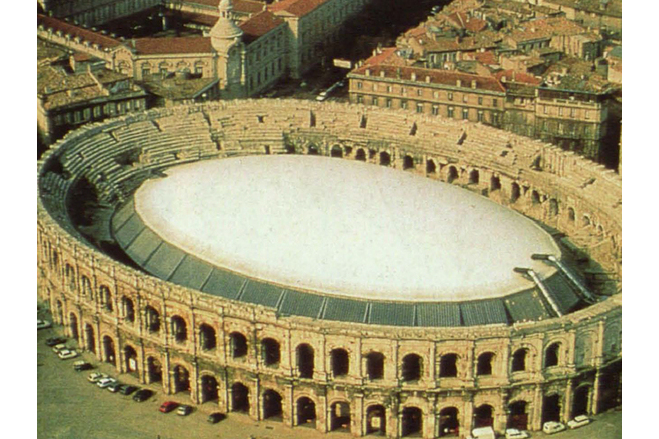Roman Arena in Nîmes
General information
-
Location address
Nîmes
-
Location country
France
-
Year of construction
1988
-
Function of building
Stadia
-
Climatic zone
Mediterranean - mild winters, dry hot summers
Description
During the 1970s, the French architects Finn Geipel and Nicolas Michelin received a brief to design a removable cover for the Roman arena in Nîmes. The roof was to have minimum impact on the ancient structure and be designed so that erection and removal would take no longer than three weeks. The architects invited Schlaich Bergermann to act as consulting engineers, and the partnership put forward an imaginative idea it had conceived in response to a similair project for the Roman arena at Verona. The idea had been to make the roof in the form of a helium-filled cushion, rather like an airship. This was to be anchored low over the arena during the winter months, but floated high above it during the summer, or even flown outside the city to be put to some other purpose.
The Verona proposal had been ruled out by safety regulations, but it was decided to retain the idea of a cushion for the Nîmes project, this time filling it with air and erecting it in a "conventional" way, rather than flying it in from elsewhere. The plan of the Nîmes arena is an ellipse with main axes of 101 and 132 metres. The solution adopted was to erect a temporary auditorium within the old one, having axes of only 57 and 88 metres. When the roof is required, thirty steel columns, ten metres high, are erected in a ring within the grandstand. A box-section steel ring-beam, which is stored in one terrace of the grandstand during the summer, is assembled and hoisted to the top of the columns. It supports the cushion and resists the circumferential compression induced in it by the inward pull of the membranes. The lower membrane of the cushion is given a curvature less than the optimum so that spectators seated in the upper rows are able to see those on the opposite side, thus preserving their sense of participation. It is allowed to sag only 4.2 metres at this centre, while the upper membrane rises an optimum 8.5 metres. As a result, high tensile forces are induced in the lower membrane by the air pressure and calculations showed that cable-net reinforcement would be necessary. These cables are exploited to provide extra stability for the ring beam, making it possible to limit its cross-setion to 30cm by 50cm. As no functional restrictions limited the curvature of the upper membrane, it could be designed to adopt a greater curvature and thus needed no cable reinforcement. The temporary inclined façade of the auditorium, spanning between the compression ring and the steps of the grandstands, consists of 480 laminated plastic translucent elements each weighing only 30 kg. Hoisting of the roof, which has an area of 4200 square metres and weighs about 40 tonnes, is carried out using 30 specially developed outrigers which are attached to the columns and raised by the same jacks used for lifting the compression ring. To avoid tearing there must be almost no wind during the erection process, which takes about five hours until the membrane is inflated. It is therefore carried out at night or in the early hours of the morning. The roof provides an excellent example of the strong tradition in the Schlaich Bergermann office of thoroughly integrating design and construction.
[The Art of Structural Engineering, The Work of Jörg Schlaich and his Team, Alan Holgate, p132,133]
Description of the environmental conditions
Material of the cover
-
Cable-net/Fabric/Hybrid/Foil
Foil
-
Material Fabric/Foil
Polyester
-
Material coating
PVC
Main dimensions and form
-
Covered surface (m2)
4800
-
Total length (m)
88
-
Total width (m)
57
Duration of use
-
Temporary or permanent structure
Permanent
-
Convertible or mobile
Convertible and mobile
-
Design lifespan in years
00-05
Involved companies
-
Architects
Finn Geipel and Nicolas Michelin
-
Engineers
schlaich bergermann partner
Editor
-
Editor
Marijke M. Mollaert



